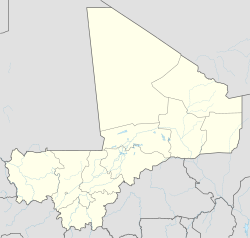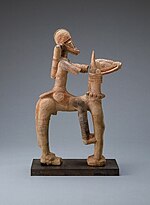Djenné
| Djenné | ||
|---|---|---|
|
|
||
| Coordinates | 13 ° 54'0 " N , 4 ° 33'0" W | |
| Basic data | ||
| Country | Mali | |
| Mopti | ||
| ISO 3166-2 | ML-5 | |
| surface | 0.9 km² | |
| Residents | 32,944 (2009) | |
| density | 37,436.4 Ew. / km² | |
|
Djenné market and mosque
|
||
Djenné [ dʒəˡneː ] is a town in the Mopti region in Mali with 32,944 inhabitants (2009 census) Djenné is located in the Massina , a 40,000 km² large lowland with an inland delta of the Niger and the Bani . The city itself is located on an 88 hectare island , lapped by a branch of the Bani , which at low tide by a ford and a dam and at high tide by a ferrycan be achieved. The nearest cities are San (150 km) and the capital Bamako (390 km) in the southwest, Mopti (130 km) and Timbuktu (350 km) in the northeast.
Although rather small, Djenné is one of the most famous cities in the Niger Inland Delta and represents the center of medieval clay architecture in the Upper Niger region. The famous Great Mosque , the medieval citizen palaces and the traditional Koran schools are still reminiscent of the former cultural marriage of the Mali and Songhay empires . Around 2000 clay buildings still exist in the old town .
history
Soninke who immigrated from the west founded Djenné around the year 800 on the foundations of an earlier settlement of Bozo fishermen. A major expansion of the city took place in the 13th century after Soninke refugees from the defunct Ghana Empire moved towards Niger and settled in Djenné.
Djenné remained a center of traditional religion for a long time , although the environment was increasingly shaped by Islam. In the 13th and 14th centuries a slow Islamization began by immigrant merchants from Mali and North Africa. Around this time, the city was moved from Djenne-Djeno, about 3 km to the southeast, to its current location.
Around the year 1300, the king of Djenné, Kanboro, converted to Islam and had the first large clay mosque built. Kanboro tried to revive the economy by settling many new residents in the city and the emerging trade. Since the Mali Empire (whose sovereignty was under Djenné) enjoyed a phase of long-lasting political stability in the 14th century, an undisturbed trade between the cities and villages in the Niger Inland Delta became possible. After Timbuktu was conquered by Mali, a centuries-old economic link developed between the two cities. Djenné supplied the Timbuktu with products from the tropical forest zone and the savannahs (e.g. food, gold and slaves). In return, Saharan rock salt, dates from the Sahara oases and North African luxury goods came from Timbuktu.
In 1486 Djenné was conquered by Sonni Ali the Great after seven years of siege and was now part of the Songhaire Empire . The economic and cultural development of Djenné continued. Among other things, a predecessor of today's Great Clay Mosque was built during the Songhai period, and the Sudanese clay architecture with the magnificent town houses reached its peak around this time.
After the Moroccan conquest of the Songhay Empire, Djenné remained a prosperous city for some time, but the collapse of the Western Trans-Saharan trade led to a decline in its importance. The main caravan route now ran further east, from Bornu to Tripoli .
During the reign of Seku Ahmadou, a radical Islamic leader of the Fulani of Massina , the city fell into a crisis. Ahmadou wanted to create a tightly administered state of God, a pure Islam should rule life. Among other things, he had the mosque from the Songhai period and many smaller mosques torn down in 1830, since the marabouts did not follow "pure" Islam. In place of the old churches there were new, less decorated buildings.
At the beginning of the French colonial era, in 1907, a new Great Mosque was built, which follows the traditional Sudanese style and is an architectural masterpiece to this day. The building was partially financed by the French state, the aim of which was to ensure that the influential class of Koran scholars would be loyal to the colonial rulers.
Attractions
The city's landmark is the large Great Mosque of Djenné , also made entirely of clay (built around 1907) directly on the large market square , where a large traditional market takes place every Monday . After each rainy season, the building is re- plastered with the participation of many residents . It is the largest earth building in the world in the Sudan earth building style. It can accommodate more than 2000 believers.
UNESCO World Heritage Site
The old town of Djenné was declared a World Heritage Site by UNESCO in 1988 . In 2012, a United Nations commemorative stamp was issued in Geneva with the motif of the old town. The excavation sites on the hills ( Tougéré ) Djeno , Kaniana , Tonomba and Hambarketolo , which also protrude from the floods, are also protected . Since 2016, however, UNESCO has put the old town on the Red List of World Heritage in Danger, because the deterioration of the building materials, urbanization and the erosion of the site, combined with general uncertainty, endanger the facility.
| UNESCO ID | Official name | region | Coordinates | Area in hectares | comment | image |
|---|---|---|---|---|---|---|
| ML-116rev | "Old Towns of Djenné" (1988) ( R ) | |||||
| 116-001 | Djenne-Djeno (old Djenné) | Mopti | 13 ° 53 ′ 24 " N , 4 ° 32 ′ 25" W. | 33.21 | ||
| 116-002 | Kaniana | Mopti | 13 ° 54 ′ 50 " N , 4 ° 34 ′ 4" W. | 22.70 | ||
| 116-003 | Tonomba | Mopti | 13 ° 54 '24 " N , 4 ° 32' 52" W. | 1.23 | ||
| 116-004 | Djenné | Mopti | 13 ° 54'20 " N , 4 ° 33'18" W. | 48.50 | with Great Mosque of Djenné |

|
| 116-005 | Hambarketolo | Mopti | 13 ° 53 ′ 42 " N , 4 ° 32 ′ 25" W. | 14.00 | ||
literature
- Charles Monteil, Djenné. Une cite soudanaise. Métropole du delta central du Niger. Paris 1932 (2nd edition 1971)
Web links
- Travel information and pictures
- Images of the mosque
- Photos from Djenné
- Entry on the UNESCO World Heritage Center website ( English and French ).
Individual evidence
- ↑ INSTAT: Results of the 2009 census (PDF; 957 kB)
- ↑ 20-minute PowerPoint presentation: Snapshots from Mali, Aug./Sept. 2012 (english)
- ↑ UNESCO World Heritage Center: Old Towns of Djenné. Accessed August 21, 2017 .
- ↑ World Heritage Africa - Old towns of Djenné. In: United Nations Trademarks, 2012 Edition. Retrieved January 29, 2013 .
- ↑ UNESCO World Heritage Center: Mali's Old Towns of Djenné on List of World Heritage in Danger. Accessed August 21, 2017 .
- ↑ Old Towns of Djenné. whc.unesco.org, accessed May 1, 2015 .
- ^ Plan de conservation et de gestion of the "Villes anciennes de Djenné" - Mali. 2008–2012 (PDF; French)
- ↑ Susan Keech McIntosh (Ed.): Excavations at Jenné-Jeno, Hambarketolo, and Kaniana (Inland Niger Delta, Mali), the 1981 Season. University of California Press, 1995, map p. 2.





